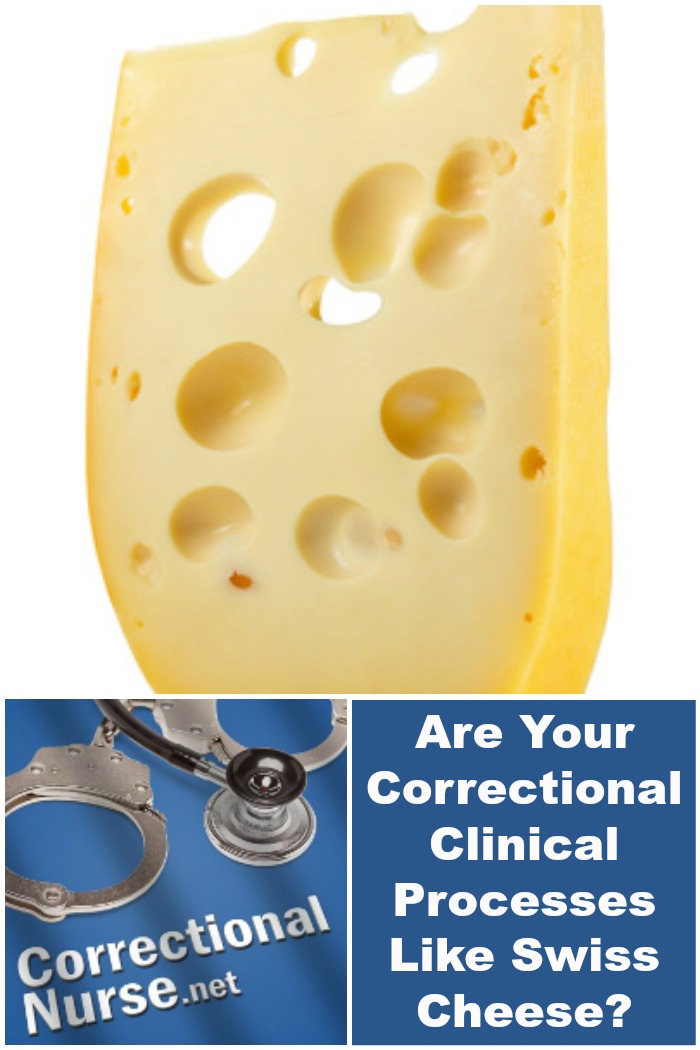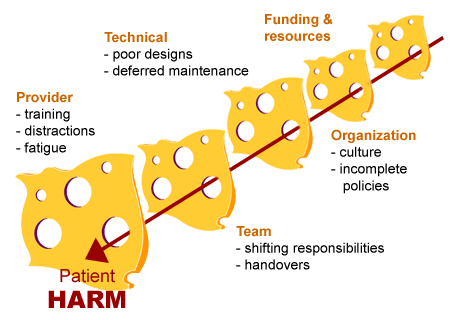 I love Swiss Cheese, don’t you? It makes everything taste better, be it a ham sandwich or a spinach omelet. Yes, Swiss cheese is welcome at my table any day of the week. However, one place Swiss cheese is not welcome is in your correctional clinical processes. No, I don’t mean you shouldn’t eat your lunch while doing Nursing Sick Call (although you shouldn’t). I’m talking about your clinical processes not being full of holes like this block of cheese on the right.
I love Swiss Cheese, don’t you? It makes everything taste better, be it a ham sandwich or a spinach omelet. Yes, Swiss cheese is welcome at my table any day of the week. However, one place Swiss cheese is not welcome is in your correctional clinical processes. No, I don’t mean you shouldn’t eat your lunch while doing Nursing Sick Call (although you shouldn’t). I’m talking about your clinical processes not being full of holes like this block of cheese on the right.
The image of a block of Swiss Cheese demonstrating the various ways we safeguard against errors in complex systems like correctional healthcare was first described by James Reason. Reason used the image of the many and varied holes in Swiss cheese to describe the gaps of protection in the safety mechanisms we have created within our various processes. So, a clinical error happens when multiple “holes” line up in the layers of system protection to allow penetration of the safety system resulting in harm. There is a visual example:
 Consider some errors from your own experiences. Although it is natural to first think about the person involved in the error (maybe the person was distracted, unskilled, or inexperienced) there are usually system issues, as well. For example, several staff were out with the flu, emergency protocols are not in place, or an important lab result was not communicated. In the correctional setting, issues with security interface, the geography of care settings within the facility, and patient population characteristics can add additional layers to further complicate the process.
Consider some errors from your own experiences. Although it is natural to first think about the person involved in the error (maybe the person was distracted, unskilled, or inexperienced) there are usually system issues, as well. For example, several staff were out with the flu, emergency protocols are not in place, or an important lab result was not communicated. In the correctional setting, issues with security interface, the geography of care settings within the facility, and patient population characteristics can add additional layers to further complicate the process.
The Swiss Cheese Model is a helpful way to debrief a clinical event to learn about patient safety gaps in your system and make course corrections. Here is a hypothetical root cause analysis for a major correctional healthcare clinical incident in the news – The Case of Courtland Lucas. Let me say right up front that this analysis is in no way a disparagement of the healthcare contractor. In fact, I have worked for this company in the past and know that there are dedicated and caring individuals seeking to deliver quality care in a challenging setting. This case was selected because it provides enough detail about the situation to suggest some Swiss Cheese hole alignments that let the clinical error ball drop through.
Courtland Lucas, a 31 year old inmate in a city jail, collapsed and died in his cell while awaiting transport to the local hospital. The legal system, looking to attribute cause, typically singles out individual error. In this case the news article suggests that staff members willfully disregarded Mr. Lucas’ medical needs. If we apply our Swiss Cheese Model we might also see some system issues that aligned to contribute to this death:
- The documentation was missing critical information about the patient’s care. How difficult is it for staff to document? For example, must staff deliver care in an outlying area and then ‘remember’ what they did long enough to write in a paper chart later in the shift when they return to the medical unit?
- What was the system for communication with the physician? What was the on-call process? Was it difficult to obtain physician advisement at 4am?
- How difficult is it to get transport for an emergency medical situation? Many minutes can be lost moving a paramedic team through various security check points and sally ports if the patient is deep within the security perimeter.
- What experience did onsite staff have with the overlapping medical conditions present? This patient, though relatively young, was withdrawing from heroin, had elevated blood sugars and a heart condition. The correctional specialty requires significant autonomous assessment and clinical judgment.
- Was there an organizational culture in custody or medical that was cynical of inmate requests? Culture is pervasive and can be absorbed, even by dedicated and caring staff. Are there ways to overcome and change such a culture?
These are just a few of my thoughts based on the news article. What else did you see? Share your thoughts in the comments section of this post. Also, let me know what you think of the Swiss Cheese analogy in looking to improve clinical processes. Do you have an alignment example to share? Use the comments section to add to the conversation.
Photo Credit: © Meliha Gojak – Fotolia.com
Leave a Reply